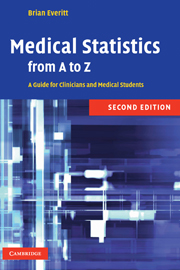P
Published online by Cambridge University Press: 23 December 2009
Summary
Paired availability design: A design that can reduce selection bias in situations where it is not possible to use random allocation of subjects to treatments. The design has three fundamental characteristics:
The intervention is the availability of treatment, not its receipt.
The population from which subjects arise is well defined with little in- or out-migration.
The study involves many pairs of control and experimental groups.
In the experimental groups, the new treatment is made available to all subjects, although some may not receive it. In the control groups, the experimental treatment is generally not available to subjects, although some may receive it in special circumstances. [Statistics in Medicine, 1994, 13, 2269–78.]
Paired Bernoulli data: Data arising when an investigator records whether a particular characteristic is present or absent at two sites on the same individual, for example the presence or absence of spots on the legs and arms. [Biometrics, 1988, 44, 253–7.]
Paired samples: Two samples of observations with the characteristic feature that each observation in one sample has one and only one matching observation in the other sample. There are several ways in which such samples can arise in medical investigations. The first,self-pairing, occurs when each subject serves as his or her own control, as in, for example, therapeutic trials in which each subject receives both treatments, one on each of two separate occasions.
- Type
- Chapter
- Information
- Medical Statistics from A to ZA Guide for Clinicians and Medical Students, pp. 171 - 188Publisher: Cambridge University PressPrint publication year: 2006



